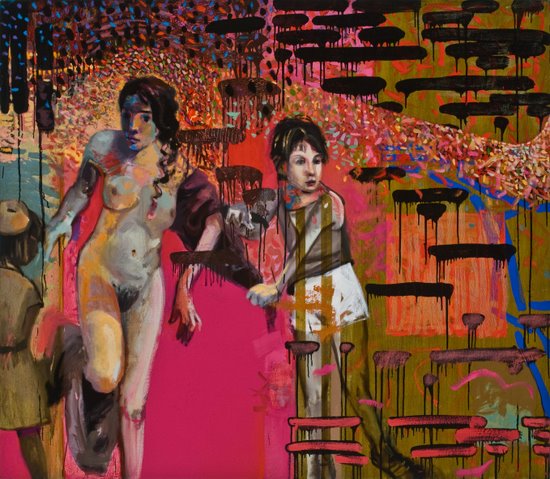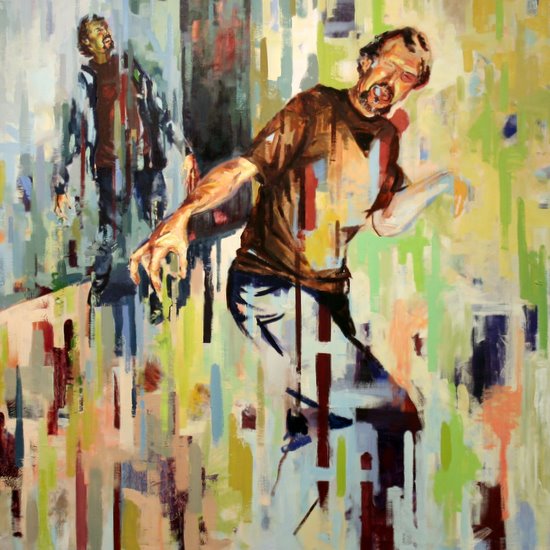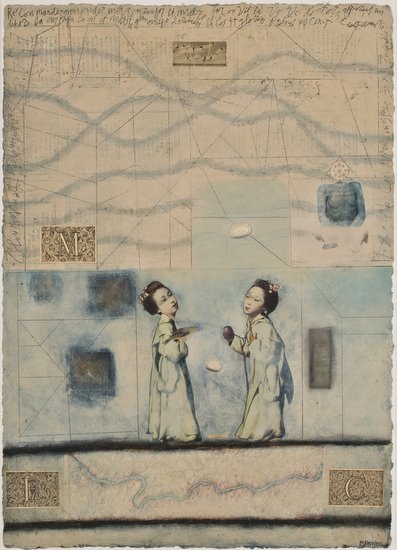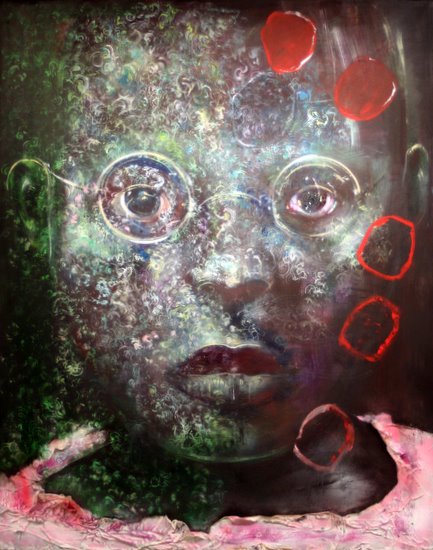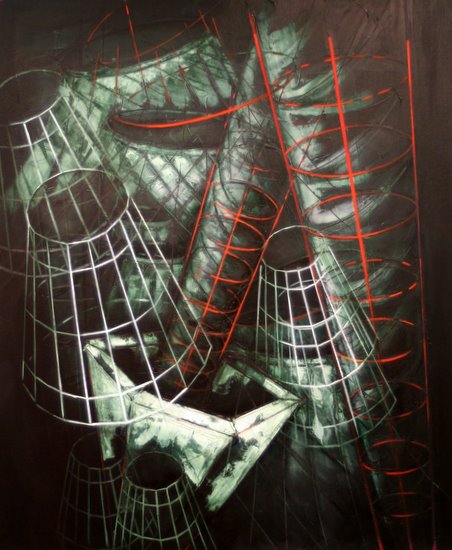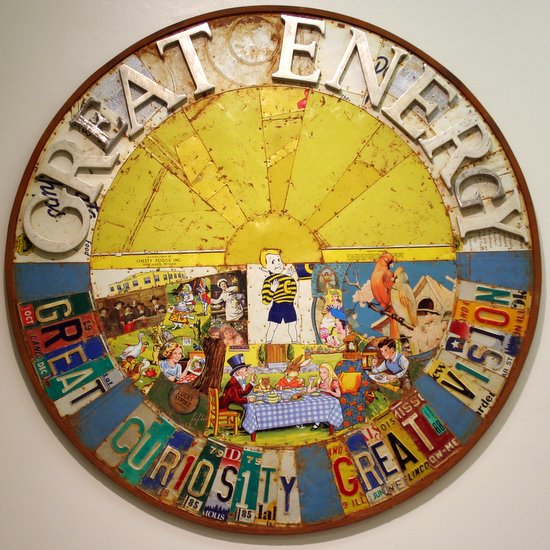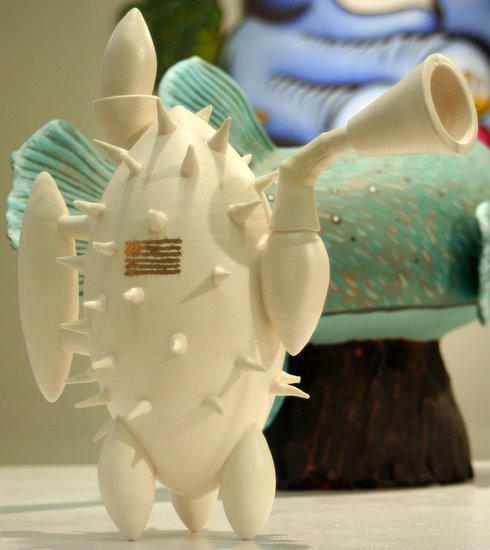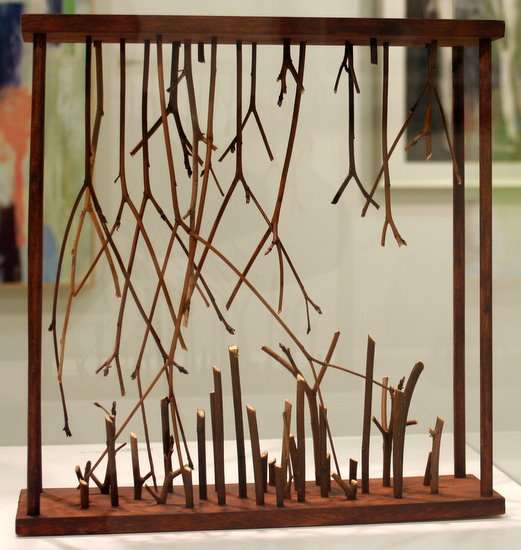You can't miss Leslie Bell's Little Guilders. His generous use of blazing hot pink and graffiti-style drips with neoclassical nudes is a compelling and somewhat mysterious blend of figurative, narrative, and abstract painting. Of the 56 works in the 35th Annual Rock Island Fine Arts Exhibition, vivid and conceptually layered two-dimensional work such as this dominates the walls, with comparatively small yet graceful three-dimensional pieces serving as complements.
The annual exhibition, in Centennial Hall at Augustana College through May 1, includes artists who live within 150 miles of the Quad Cities and awards more than $3,000 to 10 top-judged works. This year's show was juried by Dan Mills, an artist and the director of the Samek Art Gallery at Bucknell University in Pennsylvania.
About half the work Mills selected is exceptionally strong, balancing technique, aesthetic, and ideas. The remainder demonstrates technical skill but lacks the innovation or conceptual intrigue of the exhibit's best pieces.
Little Guilders, the best-in-show winner, is an oil on canvas, approximately four feet square, and features three women. The largest is nude, flanked by a casually clothed female on the right and a young girl on the left, her back to the viewer, wearing an ensemble like a school or scouting uniform. The outside characters appear to be helping the central woman step out of her clothing. The older figures seem alert and mildly worried, as they glance in different directions with concerned faces. The figures have been rendered expressively, with spots of pure gold, blue, and red layered on more natural flesh color.
The composition and paint application compete with the figures for visual control, creating tension through the push-and-pull between the background and foreground. The colors are mostly pink and warm olive, with hints of gold, blue, and purple. Small, rectangular brush strokes overlap like a school of fish, swooping across the top quarter of the work. Stark black capsule-like shapes crowd at the top of the painting, with intentional drips running down the canvas.
This background invigorates the more classical tone of the nude figure; one's eyes bounce from the women to the rowdy abstract elements. This back-and-forth keeps the viewer engaged, and compounds the enigmatic narrative of the women by adding visual content with no straightforward explanation.
Another strong figurative oil painting is Infectious Confinement by Erik Ohrn. It is roughly three by four feet and is done in a loose, blurred style. Many parts of the work appear intentionally unfinished, with foggy, watery hues generating a dream-like quality.
The painting displays two views of a man, one large in the foreground with another smaller in the top-left quarter. Both appear to be walking and searching, with anguished expressions and body language. The background figure is contained in a parallelogram, suggesting he is either in another room, a refection, or in an image hanging on a wall.
The space not occupied by the figures contains thick but short vertical lines in blue, red, green, and various neutral colors. Some of these lines appear behind the figures, while others appear in front, as if hovering in air. These shapes suggest both movement and physical barriers, and it almost looks like the man is merging with his environment. The muted and calm colors balance his distressed expressions, trading a bleak view of a tormented man for a more contemplative and nuanced tone.
Mary Clausen took second prize with her mixed-media work Gestures for Birth. Roughly two-and-a-half by four feet, the piece is handmade paper with paint, graphite, and collage on the surface. The top and bottom both feature wavy blue lines, implying a river or map. The top half has a subtly textured white background, with the bottom a light translucent blue, with thin, straight graphite lines crisscrossing the surface. Collaged throughout the work are drawings cut from old books, and the perimeter features writing done in a hurried script.
Horizontally centered in the composition are two women in traditional Asian dress. They face each other, with their heads tilted up. One has a bird on her arm, while the other holds a red, rock-like object. The handwriting and visible brush strokes offer a deliberately imperfect touch, contrasted with the rigor of the map-like elements, shapes formed by straight lines, and book illustrations. The large amount of calm background space, the consistent texture of the paper showing through thin paint, and the soft colors generate harmony. This work thoughtfully brings together science, the humanities, and nature.
Kathleen Van Hyfte contributes an engaging portrait with her acrylic and mixed-media canvas Lily, approximately three-and-a-half by four-and-a-half feet. The composition is cropped closely, filling the space with the young girl's face and the top of her shirt. The background is a pure black, increasing the drama and vibrancy of the hues layered on it.
Van Hyfte uses a repeating crescent swirl motif, applied with brushes of differing sizes and shapes, along with unnatural portrait colors - blue, yellow, pink, purple, and white - atop a smoothly rendered layer. The effect seems organically textured, as though her face were covered in a carpet of feathers or flowers. The marks are echoed by five large round, red shapes following the curve of one side of the subject's face. Another textural effect was created through blowing, dripping, and splattering paint on inconspicuous areas of the canvas.
The girl wears glasses and a feminine shirt, created with actual lace painted and attached to the canvas. She stares at us with a curious expression, normal for a child but for the dark colors and large scale. As a portrait of a youth, Lily is an engrossing treatment: Instead of a cute aesthetic, Van Hyfte used color contrast and complex yet sparse layering marks to impose intensity.
Jessica Gondek's oil on canvas work Sagrada Familia I has a similar size, format, and color scheme. This painting also has a black background, covered with overlapping red and white wire-frame conical shapes. The painting contains a middle layer with thick, light-green paint applied in a way that echoes and gives depth to the cones. Upon close inspection, one can see areas where parts of this layer have been scratched into, providing visual interest and textural variety.
Differences in scale and the overlapping of the shapes suggest that they are in motion, and the contrast between the black background and the red and white foreground lines establishes a sense of energy. The name of the work provides possible interpretations: Do the shapes represent an aspect of family or religion, or are they meant to resemble the spires of the Sagrada Familia church in Barcelona? Whatever you see in it, the deep black with vibrant red, the precisely organized lines, the repetition, and the composition combine to create a work at once elegant and forceful.
Terry Rathje's mixed-media What It Takes is about three feet in diameter, with the words "Great Energy" (using letters from old signs) along the perimeter of the top half and "Great Curiosity Great Vision" (using cut-up license plates) along the bottom. The top half features a flat, graphic sunrise made of yellow scrap metal. The bottom contains collaged images from various retro print sources, including a section of a Rembrandt painting, an illustration from Alice's Adventures in Wonderland, and illustrations of angels, children, and birds. At the center of it all is a mid-20th Century graphic of a proud-looking boy. The use of antique advertising, religious, artistic, and children's imagery with re-purposed industrial detritus feels nostalgic, but the tone is ambiguous: These cultural artifacts are visually uplifting and unified, yet they almost seem too sweet.
Sculpture, with only 10 works selected, isn't nearly as well-represented as two-dimensional art in the show. Many functional sculptures exhibit subdued beauty and fine craftsmanship, and a few other three-dimensional pieces stand out, intellectually and aesthetically vigorous. But their subtlety and relatively small scale mean they're somewhat lost among the more vibrant 2D standouts.
Scott Lammer re-imagines the form of a teapot in his ceramic work Loud Mouth. The body resembles a pointed egg, with a similar shape repeated for the handle, stopper, feet, and base of the spout. The center form is covered with tapered spikes, and two small, simplified, gold American flags - intentionally scratched and abraded - have been painted on the surface. The spout itself resembles a bullhorn. With its allusions to politics and speech, Loud Mouth cleverly references the tea-party movement. The cartoony appearance of the shapes, the aggressive spikes, and the disparaging title represent an unmistakable critique.
Joan Webster-Vore's Connection #1 is a precise wooden frame, about one foot squared, containing thin, cut branches. The sticks on the bottom, standing upright, are mostly lopped off before they fork, while the sticks hanging from the top are thinner and longer, branching off before being trimmed. The branches frame a void, and the careful creation of this negative space implies meaning. Connection #1 exhibits simple, spare media use but is notable for its openness and visual balance.
Although they're overwhelmed by the boldness of much of the two-dimensional work, these sculptural pieces, and some of the more low-key hanging work, are worth seeking out.
The Rock Island Fine Arts Exhibition runs through May 1 in Augustana College's Centennial Hall art gallery (3703 Seventh Avenue in Rock Island). The gallery is open noon to 4 p.m. Tuesdays through Saturdays and on April 3, April 10, April 17, and May 1. (The gallery will be closed April 22 to 24.) A reception for the exhibit will be held Friday, April 1, from 4:30 to 6:30 p.m.
Michelle Garrison is a mixed-media artist who teaches art and design at Geneseo Middle School and J.D. Darnell High School. She can be reached at michelle_m_garrison@hotmail.com.

